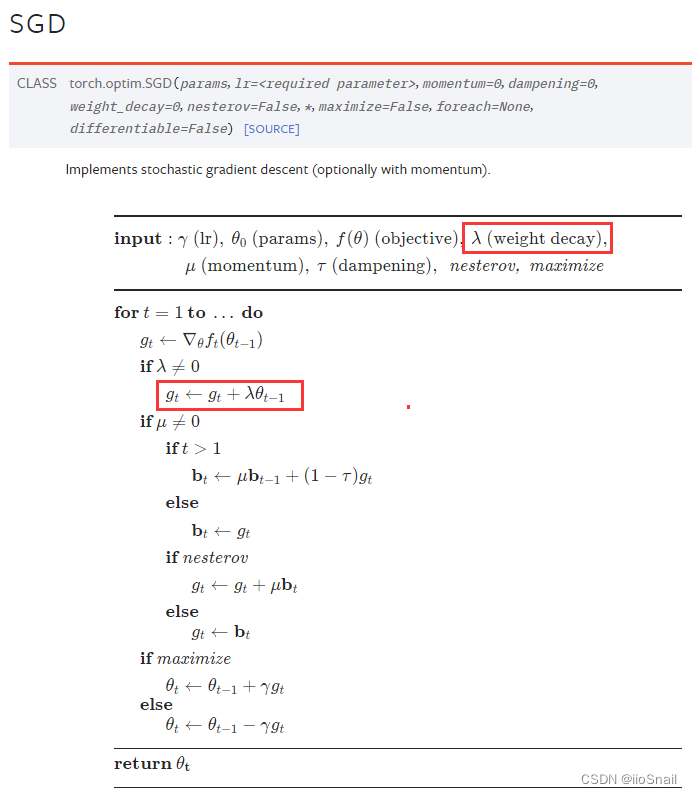机器学习中的权重衰退 —— 深度学习中的权重衰退 —— 权重衰退 —— weight decay
在看代码时看到了这个概念,以前虽然也看到过但是没有太在意,再次看到于是研究了一下。
引自:
https://sota.jiqizhixin.com/models/methods/0bdb8f87-9c05-483e-af49-e1140b9e7d19

直接说答案,weight decay 就是L2 Regularization 。
引自:
https://www.jianshu.com/p/995516301b0a

其实在深度学习框架中的优化器参数中就可以设置weight decay,如:

============================================
引自:
https://blog.csdn.net/zhaohongfei_358/article/details/129625803
weight_decay的一些trick:
- weight_decay并没有你想想中的那么好,它的效果可能只有一点点,不要太指望它。尤其是当你的模型很复杂时,权重衰退的效果可能会更小了。
- 通常取1e-3,如果要尝试的话,一般也就是1e-2, 1e-3, 1e-4 这些选项。
- 权重衰退通常不对bias做。但通常bias做不做权重衰退其实效果差不多,不过最好不要做。
- weight_decay取值越大,对抑制模型的强度越大。但这并不说明越大越好,太大的话,可能会导致模型欠拟合。
============================================
给出chainer框架中的实现:(不对bias进行decay,只对weight进行decay)
地址:
https://github.com/chainer/chainerrl/blob/master/chainerrl/optimizers/nonbias_weight_decay.py
class NonbiasWeightDecay(object):
"""Weight decay only for non-bias parameters.
This hook can be used just like chainer.optimizer_hooks.WeightDecay except
that this hook does not apply weight decay to bias parameters.
This hook assumes that all the bias parameters have the name of "b". Any
parameter whose name is "b" is considered as a bias and excluded from
weight decay.
"""
name = 'NonbiasWeightDecay'
call_for_each_param = True
timing = 'pre'
def __init__(self, rate):
self.rate = rate
def __call__(self, rule, param):
if param.name == 'b':
return
p, g = param.array, param.grad
if p is None or g is None:
return
with cuda.get_device_from_array(p) as dev:
if int(dev) == -1:
g += self.rate * p
else:
kernel = cuda.elementwise(
'T p, T decay', 'T g', 'g += decay * p', 'weight_decay')
kernel(p, self.rate, g)
def add_hook(self, hook, name=None, timing='auto'):
"""Adds a hook function. The hook function is called before or after any updates (see the timing
attribute). Args:
hook (callable): Hook function to be added. It takes two
arguments: the update rule object and the parameter variable.
name (str): Name of the hook function. The name attribute of the
hook function is used by default.
timing (str): Specifies when the hook is called. If 'auto', the
timimg property of the hook will decide the timing.
If 'pre', the hook will be called before any updates.
If 'post', the hook will be called after any updates.
If 'auto' and the timing property of the hook is not
available, timing will default to 'pre'. """
if not callable(hook):
raise TypeError('hook function must be callable')
if timing not in ('pre', 'post', 'auto'):
raise ValueError("timing must be one of ('pre', 'post', 'auto')")
if timing == 'auto':
timing = getattr(hook, 'timing', 'pre') if name is None:
name = getattr(hook, 'name', getattr(hook, '__name__', None))
if name is None:
raise ValueError(
'the name of the hook function is not specified')
if name in self._pre_update_hooks or name in self._post_update_hooks:
raise ValueError('hook "{}" already exists'.format(name)) if timing == 'pre':
self._pre_update_hooks[name] = hook
else:
self._post_update_hooks[name] = hook def remove_hook(self, name):
"""Removes the specified hook function. Args:
name (str): Name of the hook function to be removed. The hook
function registered with this name will be removed. """
try:
del self._pre_update_hooks[name]
except KeyError:
del self._post_update_hooks[name] def update(self, param):
"""Invokes hook functions and updates the parameter. Args:
param (~chainer.Variable): Variable to be updated. """
if not self.enabled:
return self.t += 1 if self._use_fp32_update and param.dtype == numpy.float16:
if self._fp32_param is None:
self._fp32_param = variable.Variable(
param.array.astype(numpy.float32),
name=param.name)
fp32_param = self._fp32_param
fp32_param.grad = param.grad.astype(numpy.float32) if fp32_param.data is not None:
self._prepare(fp32_param)
if param._loss_scale is not None:
fp32_param.grad /= param._loss_scale
for hook in six.itervalues(self._pre_update_hooks):
hook(self, fp32_param)
self.update_core(fp32_param)
for hook in six.itervalues(self._post_update_hooks):
hook(self, fp32_param) param.data = fp32_param.data.astype(param.dtype)
fp32_param.grad = None
else:
if param.data is not None:
self._prepare(param)
if param._loss_scale is not None:
param.grad /= param._loss_scale
for hook in six.itervalues(self._pre_update_hooks):
hook(self, param)
self.update_core(param)
for hook in six.itervalues(self._post_update_hooks):
hook(self, param)
============================================
参考:
https://www.jianshu.com/p/995516301b0a
https://blog.csdn.net/zhaohongfei_358/article/details/129625803
机器学习中的权重衰退 —— 深度学习中的权重衰退 —— 权重衰退 —— weight decay的更多相关文章
- 机器学习之路:tensorflow 深度学习中 分类问题的损失函数 交叉熵
经典的损失函数----交叉熵 1 交叉熵: 分类问题中使用比较广泛的一种损失函数, 它刻画两个概率分布之间的距离 给定两个概率分布p和q, 交叉熵为: H(p, q) = -∑ p(x) log q( ...
- 深度学习中常见的 Normlization 及权重初始化相关知识(原理及公式推导)
Batch Normlization(BN) 为什么要进行 BN 防止深度神经网络,每一层得参数更新会导致上层的输入数据发生变化,通过层层叠加,高层的输入分布变化会十分剧烈,这就使得高层需要不断去重新 ...
- 深度学习中Dropout原理解析
1. Dropout简介 1.1 Dropout出现的原因 在机器学习的模型中,如果模型的参数太多,而训练样本又太少,训练出来的模型很容易产生过拟合的现象. 在训练神经网络的时候经常会遇到过拟合的问题 ...
- 卷积在深度学习中的作用(转自http://timdettmers.com/2015/03/26/convolution-deep-learning/)
卷积可能是现在深入学习中最重要的概念.卷积网络和卷积网络将深度学习推向了几乎所有机器学习任务的最前沿.但是,卷积如此强大呢?它是如何工作的?在这篇博客文章中,我将解释卷积并将其与其他概念联系起来,以帮 ...
- 深度学习中的Normalization模型
Batch Normalization(简称 BN)自从提出之后,因为效果特别好,很快被作为深度学习的标准工具应用在了各种场合.BN 大法虽然好,但是也存在一些局限和问题,诸如当 BatchSize ...
- [优化]深度学习中的 Normalization 模型
来源:https://www.chainnews.com/articles/504060702149.htm 机器之心专栏 作者:张俊林 Batch Normalization (简称 BN)自从提出 ...
- Hebye 深度学习中Dropout原理解析
1. Dropout简介 1.1 Dropout出现的原因 在机器学习的模型中,如果模型的参数太多,而训练样本又太少,训练出来的模型很容易产生过拟合的现象. 在训练神经网络的时候经常会遇到过拟合的问题 ...
- zz详解深度学习中的Normalization,BN/LN/WN
详解深度学习中的Normalization,BN/LN/WN 讲得是相当之透彻清晰了 深度神经网络模型训练之难众所周知,其中一个重要的现象就是 Internal Covariate Shift. Ba ...
- 模型汇总24 - 深度学习中Attention Mechanism详细介绍:原理、分类及应用
模型汇总24 - 深度学习中Attention Mechanism详细介绍:原理.分类及应用 lqfarmer 深度学习研究员.欢迎扫描头像二维码,获取更多精彩内容. 946 人赞同了该文章 Atte ...
- 深度学习中正则化技术概述(附Python代码)
欢迎大家关注我们的网站和系列教程:http://www.tensorflownews.com/,学习更多的机器学习.深度学习的知识! 磐石 介绍 数据科学研究者们最常遇见的问题之一就是怎样避免过拟合. ...
随机推荐
- 洛谷 P4343 自动刷题机
题目链接:自动刷题机 思路 二分典题,两个二分判断出可能的最大值和最小值.需要注意当删掉y行代码后,当前代码行数小于0时需要将代码行数重新赋值为0,然后需要注意二分的n最大值的边界,因为x[i]的最大 ...
- js-文件读写和上传下载的简单例子01
现下,网络越来越快,浏览器的功能和性能越来越好,所以很多时候,已经不需要一些复杂的框架来实现不是非常复杂的功能. 我们只有在以下情况才会考虑使用框架或者现成的第三方组件: 1.功能复杂,自己写没有必要 ...
- 15分钟面试被5连CALL,你扛得住么?
最近一个朋友跳槽找工作,跟V 哥说被15分钟内一个问题5连 CALL,还好是自己比较熟悉的技术点,面试官最后跟他说,面了几十个人,你是第一个回答比较满意的,我好奇都是什么问题,原来是关于锁的问题连环问 ...
- HDD成都站:HMS Core 6.0带来新可能,多元服务驱动产品价值提升
9月10日,由华为开发者联盟主办的HDD(Huawei Developer Day)于成都举行.活动中,华为HMS Core各领域专家重点解读了HMS Core 6.0为开发者带来的多项全新能力,及生 ...
- arm 移植 lighttpd + CGI 配置
--- title: arm 移植 lighttpd + CGI 配置 EntryName: porting-lighttpd-on-arm-and-make-cgi-config date: 202 ...
- uniapp+thinkphp5实现微信扫码支付(APP支付)
前言 统一支付是JSAPI/NATIVE/APP各种支付场景下生成支付订单,返回预支付订单号的接口,目前微信支付所有场景均使用这一接口.下面介绍的是其中APP的支付的配置与实现流程 配置 1.首先登录 ...
- Unity 中关于SubMesh的拾取问题
问题背景 最近在开发一个功能,钻孔功能,每一层(段)都需要单独拾取,显示不同的颜色,使用不同材质 问题分析 对于这个功能,由于上述需求,很容易想到用submesh实现,但是主要问题是在于对于Subme ...
- 本地自建KMS服务器
本地自建KMS服务器 本地自建KMS服务器 一.前期准备 下载安装以下软件.文件: VMware Github中的开源项目:vlmcsd 二.在VMware下部署KMS服务器 解压vlmcsd项目中r ...
- 一个用来画拉氏图的简单Python脚本
技术背景 关于拉氏图的更多介绍,可以参考下这篇博客,这里简单引述一部分内容: Ramachandran plot(拉氏图)是由G. N. Ramachandran等人于1963年开发的,用来描述蛋白质 ...
- Java FastJson解析json字符串
json转map Map<String, 实体类> titleMap=JSON.parseObject(JSON字符串, new TypeReference<HashMap<S ...
